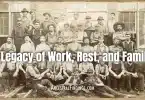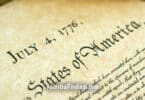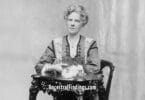It wasn’t meant to be extraordinary—a simple casting of metal forged to mark time and announce gatherings. Yet, from the moment it arrived, it seemed destined for something far greater. Shipped across the ocean, cracked, recast, and ultimately silenced, this humble creation would witness the birth of a nation and become a silent voice for freedom. Through wars, protests, and celebrations, it endured, growing into a symbol of resilience and hope. Let’s explore how the Liberty Bell, an iconic piece of history, came to embody the spirit of a country.
The Bell’s Beginnings: Commission and Creation
In 1751, the Pennsylvania Provincial Assembly decided to order a bell for the new Pennsylvania State House in Philadelphia (now known as Independence Hall). The assembly wanted to commemorate the 50-year anniversary of William Penn’s Charter of Privileges, the founding document of Pennsylvania, which emphasized religious tolerance, individual rights, and the freedoms cherished by early settlers. This bell would not only ring for public gatherings but symbolize the principles of liberty central to the colony’s foundation.
The assembly commissioned the bell from the Whitechapel Bell Foundry in London, a distinguished foundry established in 1570 and known for producing high-quality bells for churches and buildings across Europe. Whitechapel’s founders specialized in the art of bell-making, with craftsmen whose techniques were passed down over generations. After receiving the order, they cast the 2,080-pound bell, including an inscription chosen by the assembly: “Proclaim LIBERTY Throughout all the Land unto all the Inhabitants Thereof” (Leviticus 25:10). This message would later prove deeply prophetic for the bell’s role in American history.
The Bell Arrives in Philadelphia: The First Crack
When the bell arrived in Philadelphia in August 1752, anticipation was high. However, the initial ringing revealed an unexpected flaw: the bell cracked immediately. News of this defect quickly reached Philadelphia’s local foundry workers John Pass and John Stow, who took on the responsibility of recasting the bell using the original metal. Pass and Stow melted down the bell, added additional copper to the alloy for resilience, and recast it. This new version, bearing the inscription “Pass and Stow / Philada / MDCCLIII” (1753), still did not produce the perfect sound the assembly hoped for, leading Pass and Stow to recast the bell yet again. Finally, this third casting would be the one that hung in the State House.
The Liberty Bell in Early American Life
Throughout the colonial period, the bell served its purpose as an important part of daily life in Philadelphia. It rang to summon lawmakers to sessions, announce public gatherings, and signal times of celebration or mourning. But it wasn’t until 1776 that the bell would become connected to the cause of American independence. On July 8, 1776, just four days after the Continental Congress adopted the Declaration of Independence, the bell rang out to call Philadelphians to hear the first public reading of the Declaration. Thousands gathered as the words of freedom and equality echoed across the city, the bell’s sound ringing in what would become a turning point in American history.
During the Revolutionary War, Philadelphia was a central target for the British army, and local residents feared that the bell could be captured and melted down to produce cannons or ammunition. In a daring operation, patriots transported the bell, along with other valuable bells from the city, to Allentown, Pennsylvania, where it was hidden beneath the floorboards of the Zion Reformed Church. The bell remained safely in Allentown until the British evacuated Philadelphia, and it returned to its place of honor in 1778.
The Silent Years and the Famous Crack
The bell continued its service, ringing on significant occasions and marking moments in the city’s life, but it eventually began to show signs of wear. The exact timing and cause of the bell’s famous crack remain subjects of debate, but many historians believe that the break began sometime in the early 19th century. By 1835, the crack had become severe enough to affect the bell’s sound, and after ringing for the funeral of Chief Justice John Marshall in 1835, the bell developed a larger crack, rendering it permanently unfit for use.
An attempt to repair the crack in 1846, allowing it to ring for George Washington’s birthday, was unsuccessful, and the bell was finally silenced for good. Yet this flaw became its most distinguishing feature, and it was during this period that the bell began to transition from a functional instrument to a cherished national symbol.
A Symbol of Freedom: The Liberty Bell and Abolitionists
Around the time the Liberty Bell went silent, a new movement was taking shape in America: abolitionism. The bell’s biblical inscription, “Proclaim LIBERTY Throughout all the Land unto all the Inhabitants Thereof,” resonated powerfully with abolitionists, who saw in it a call to end the institution of slavery. Abolitionists adopted the bell as a symbol of their cause, giving it the name “Liberty Bell” and using its image on pamphlets, posters, and newspapers. By the 1830s and 1840s, the bell had become a beacon for freedom and justice, representing the fight to extend liberty to all Americans.
The bell’s legacy continued to grow as it became intertwined with the broader struggle for equality. It was a silent witness to the Civil War and the eventual emancipation of enslaved individuals in the United States, taking on new meaning as a symbol of freedom and equality for all people.
The Liberty Bell’s Cross-Country Journey
Following the Civil War, the Liberty Bell took on another role: as a national unifier. In the late 19th and early 20th centuries, the bell toured the United States, traveling from city to city as a symbol of unity and resilience. From 1885 to 1915, the bell visited major cities, fairs, and expositions, reaching millions of Americans and solidifying its place in the national consciousness. People of all ages, races, and backgrounds gathered to see it, and souvenir replicas were made to commemorate the visits. During these tours, the Liberty Bell became a symbol of both American independence and the sacrifices made to secure freedom.
D-Day and a Rare Echo of Liberty
Though silenced by its crack, the Liberty Bell would once again play a symbolic role on a momentous day: June 6, 1944, D-Day. As Allied forces stormed the beaches of Normandy, Philadelphia Mayor Bernard Samuel struck the Liberty Bell with a cushioned mallet, seven times—once for each letter in the word “Liberty.” Broadcast nationwide, this ringing was heard as a call to unity and resilience, reminding Americans of the freedom their soldiers were fighting to protect. This rare and symbolic “ringing” of the Liberty Bell resonated deeply, representing the ideals that lay at the heart of the war effort.
After this solemn tribute, officials decided never to strike the Liberty Bell again to preserve its structural integrity, allowing it to remain an undamaged symbol for future generations.
The Liberty Bell Today: Legacy and Preservation
Today, the Liberty Bell resides in the Liberty Bell Center in Philadelphia, which draws millions of visitors annually. From a colonial artifact to a national emblem, it remains a part of the American story that speaks to the timeless journey toward liberty and justice for all.
For those interested in delving deeper into its history and significance, here are some insightful books.
Authored by historian Gary B. Nash, this book offers a comprehensive exploration of the Liberty Bell’s origins, its evolving symbolism, and its enduring place in American culture.
The Liberty Bell and Its Legacy: An Encyclopedia of an American Icon in U.S. History and Culture
Compiled by John R. Vile, this encyclopedia provides an in-depth look at the Liberty Bell’s history, its cultural impact, and its role in various social movements throughout U.S. history.
This book, written by Mary Firestone, offers an engaging overview of the Liberty Bell’s history and significance, making it accessible to readers of all ages.






